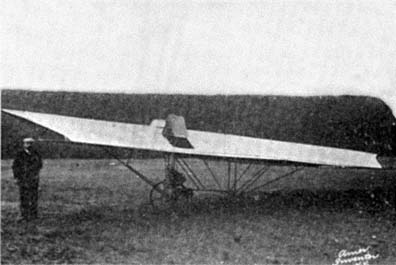

CONQUERING the atmosphere and moving freely about therein in all directions, in emulation of birds, is a problem which has interested investigators for many years past. Most of us are familiar with the history of these hardy pioneers of science who, entrusting themselves to the frail support of an often very ingenious but mostly imperfect flying machine, have boldly launched out into space in the hope of moving and travelling safely therein. Unfortunately, however, all the attempts so far made have been unsuccessful and often been attended by loss of life. Despite this, inventors and men of science of all countries continue to devote themselves persistently to the study of human flying capabilities.
To-day we have to report some fresh experiments just made in Harad, in Hungary. Mr. Némethy, the inventor of the machine just tested, is a specialist in this branch of science. Only a couple of years ago he experimented with a machine constructed on the well known kite principle.
In the course of the experiments made with his first apparatus, the inventor acquired the conviction that, unless it were possible to have a quantity of energy absolutely out of proportion with the effect produced, it would never be possible to traverse a considerable distance in a horizontal direction. He then abandoned his researches but took them up again a little later, taking as his basis the principle of the paper dart with which the school boys amuse themselves.
The result of these new investigations was that he designed the aeroplane of which we give an illustration, and which is nothing more or less than a gigantic dart constructed according to scientific rules.
The length of the apparatus is 10 metres, its maximum width 4 metres and its total superficial area 28 square metres. The wings are made of silk, and the frame is of aluminum. The whole rests upon an arrangement provided with wheels, which carries in the forepart, a small benzine motor developing 2 1/4 Hp. and making 180 revolutions per minute. This power is transmitted by means of belting to a propeller placed between the wings and giving the apparatus the necessary speed of horizontal movement. The propeller, the diameter of which is 1 m. 60 cm., is provided with two blades and its speed is from 300 to 600 revolutions per minute.

NÉMETHY'S NEW
AEROPLANE.
The two wings of the aeroplane are inclined at an angle of 22 deg. 30 min. in relation to the horizon, so as to obtain the maximum section for the strata of air which sustains the machine. The whole arrangement, including the motor, weighs about 70 kilogrs., and is steered by means of rudders. The wheels serve for starting and coming to earth, and they effect the latter operation very gently, all shock being taken up by reason of the fact that the apparatus does not fall flat but touches the earth with rubber-tired wheels upon which it continues to roll for some seconds.
For starting purposes, these wheels are actuated separately by the motor, in such a way that the machine travels along the road like a motor car until it has attained the speed requisite to enable it to commence its ascent.
Due to the power of the motor, the speed of flight obtained during the trials was not great, but the inventor asserts that stability was maintained constant throughout the flight and that the starting and coming to earth were carried out perfectly.
Hence with a few slight modifications and a more powerful motor, he hopes to be able to construct a machine that will fly through the empyrean in perfect safety and in all directions even in the face of opposing currents of air.
Originally appeared in American Inventor, 16, July 1907, p. 3.
sbck/htgb